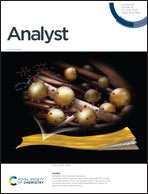A fluorescent biosensor based on carbon quantum dots and single-stranded DNA for the detection of Escherichia coli
Abstract
To detect E. coli in food, a simple fluorescent biosensor based on single-stranded DNA (ssDNA) and carbon quantum dots (CQDs) was developed. The carbon quantum dots were synthesized using a superhydrothermal method with carrot juice as a carbon source. The fluorescence intensity of the CQDs was decreased by induced ssDNA attachment. In the presence of E. coli, ssDNA preferentially binds to E. coli through hydrogen bonding and its fluorescence is greater than that in the absence of E. coli. The results showed that the linear range of the sensor was 1 × 102–1 × 108 CFU mL−1 with a coefficient of determination (R2) of 0.9870. The detection limit for E. coli was 60 CFU mL−1.



 Please wait while we load your content...
Please wait while we load your content...